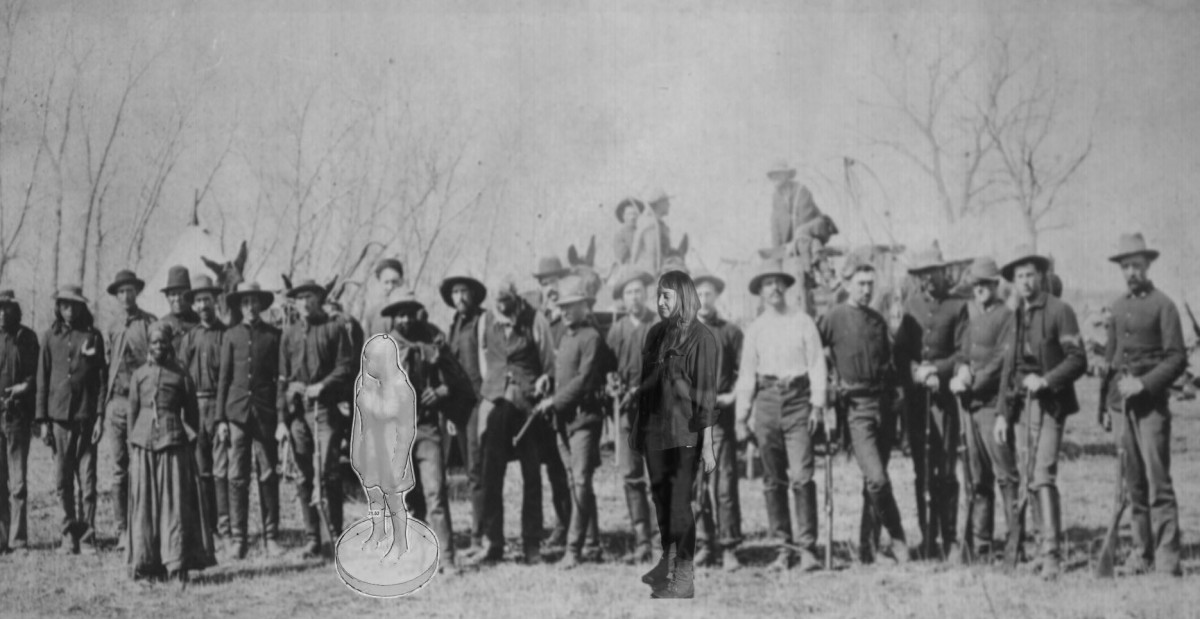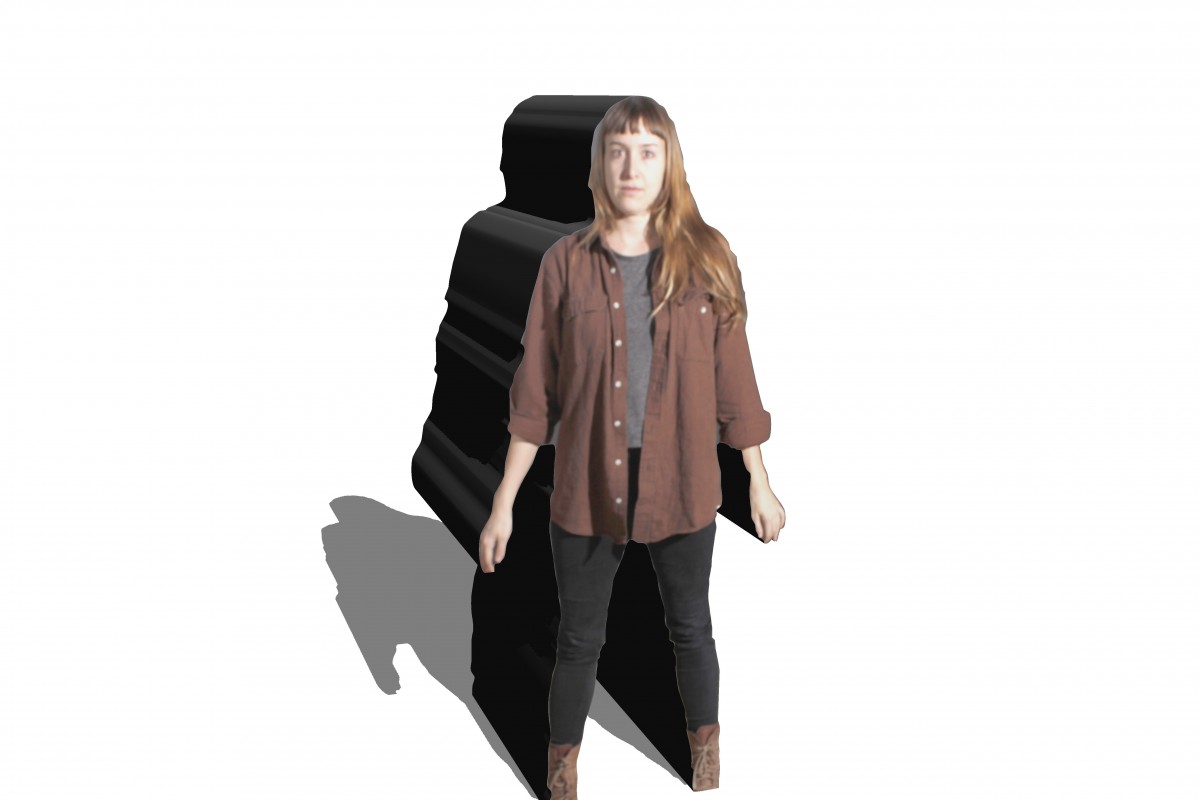Category Archives: Blue Rabbit
4th Iteration-figurine
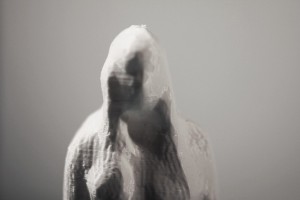 My Blue Rabbit project is like something
My Blue Rabbit project is like something
out of a twisted feminist sci-fi dream. I wanted to bring self-portraiture and virtual reality/identity together to create a model of myself that in theory was born out of my virtual presence on social media. Imagine the attributes of your facebook, okcupid, etc. coming to life, being born through the 3D printer womb and living as you. Obviously, with out imagination, this project does not work. The reality is a 5 inch figurine that is inanimate, essentially faceless, and perhaps even boring. The use of film to ‘animate’ or bring to life this plastic self image is key to sharing this idea quickly and creatively to an outside audience. I considered many options on how to portray her voice, her personhood. Should I speak using my voice? Should I use a robots voice reading text I wrote? Should I use text, silent and open to interpretation?
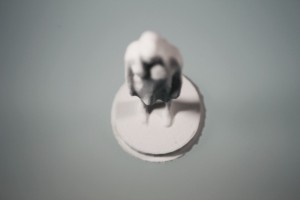
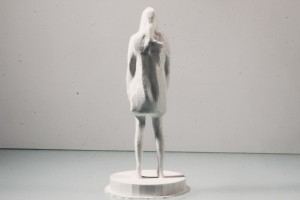
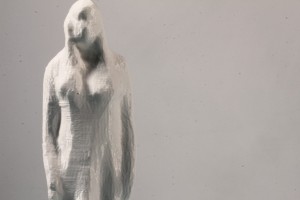 My 3D ‘replica’ is 154mm (6 inches) tall, 69mm wide, and 66mm deep. My RL body is 1,676.4mm tall. ‘She’ is made of 33g of plastic filament compared to my 56699g of ‘natural’ filament. It took ‘her’ 6 hours to print, where as my mother was in labor with me for 12.
My 3D ‘replica’ is 154mm (6 inches) tall, 69mm wide, and 66mm deep. My RL body is 1,676.4mm tall. ‘She’ is made of 33g of plastic filament compared to my 56699g of ‘natural’ filament. It took ‘her’ 6 hours to print, where as my mother was in labor with me for 12.
Designing myself was easy. I stood in front of a scanner. I played with positions of my arms, and my posture, which at that moment seemed so incredibly important. I was constrained in movement and detail. My posture would forever be cast into plastic, representing me in form as slightly more than an amorphous white blob. My arms had to stay fixed at my sides or at least have my hands attaching somewhere. My legs are also fixed, immobile and in Tinkercad became rooted to a cylindrical platform to allow my replica to stand on her own, to have a platform, literally. I chose a white filament to catch lights and show shadow and texture. I considered painting ‘her’ but decided it would take away from the raw machine made feel it had.
After her lead role in Cyborga, my 3D model will most likely retire to a shelf in my house a souvenir of exploring my relationship with my virtual self. Her legacy will live on in my future work exploring the intersection of feminism, identity, and technology through art.
3rd Iteration photo: Cyborgs humans animals time
What is the relationship between human, machine, and animal in terms of cyberfeminism?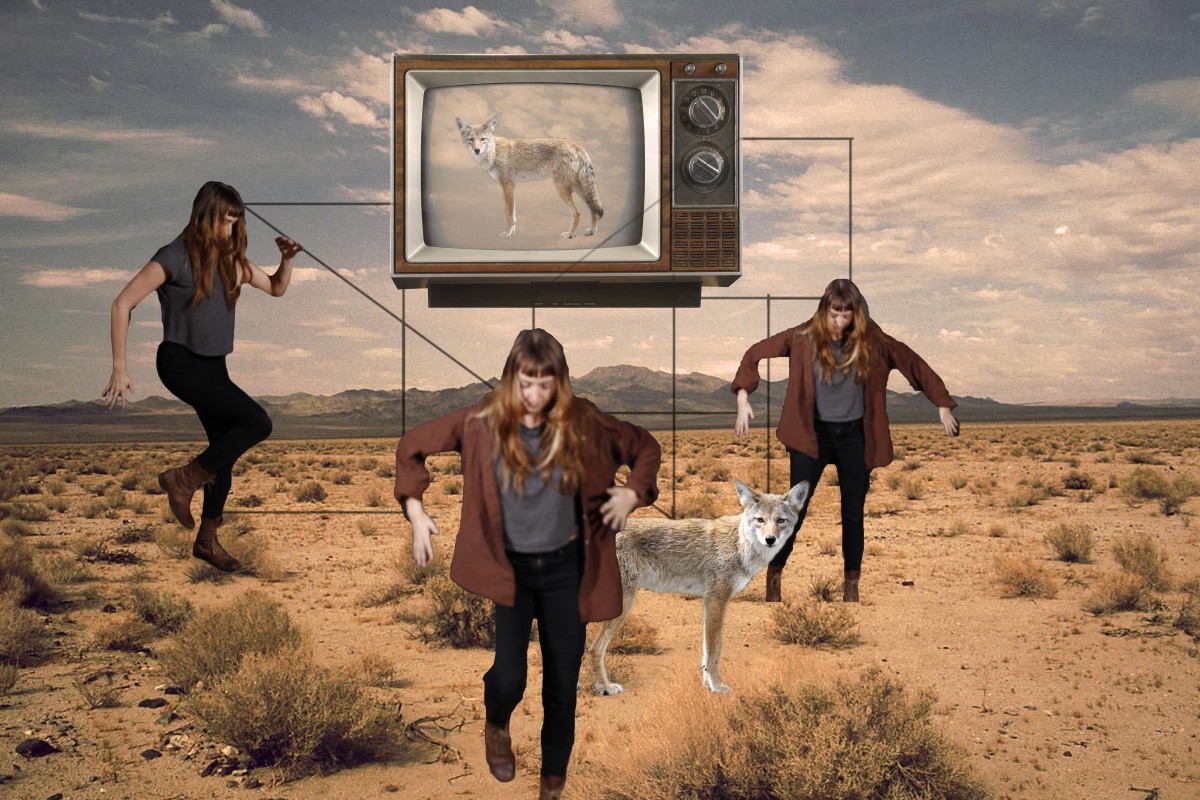
This image is a created based on Donna Haraways Cyborg Manifesto. The connection of animal to human to machine- natural/non-natural, work to create a kind of self portrait, as my project itself is a form of self-portraiture.
As I extend myself into future, upload download manipulate and reproduce, I look to the past. I grew up in Arizona, the desert, on disputed land, on stolen land. A photograph from the Archived west, white men-Troop C, 5th Calvary to be exact, who arrested boomers and squatters prior to opening of Oklahoma, no mention of the role of the black woman- or of course the cyborg and white woman from 2014.
Troop`C,’ 5th Cavalry, which arrested boomers and squatters prior to opening of Oklahoma, ca. 1888. 111-SC-87369.
Cyborg. 2012. http://konspektikaust.files.wordpress.com/2012/11/cyborg.jpg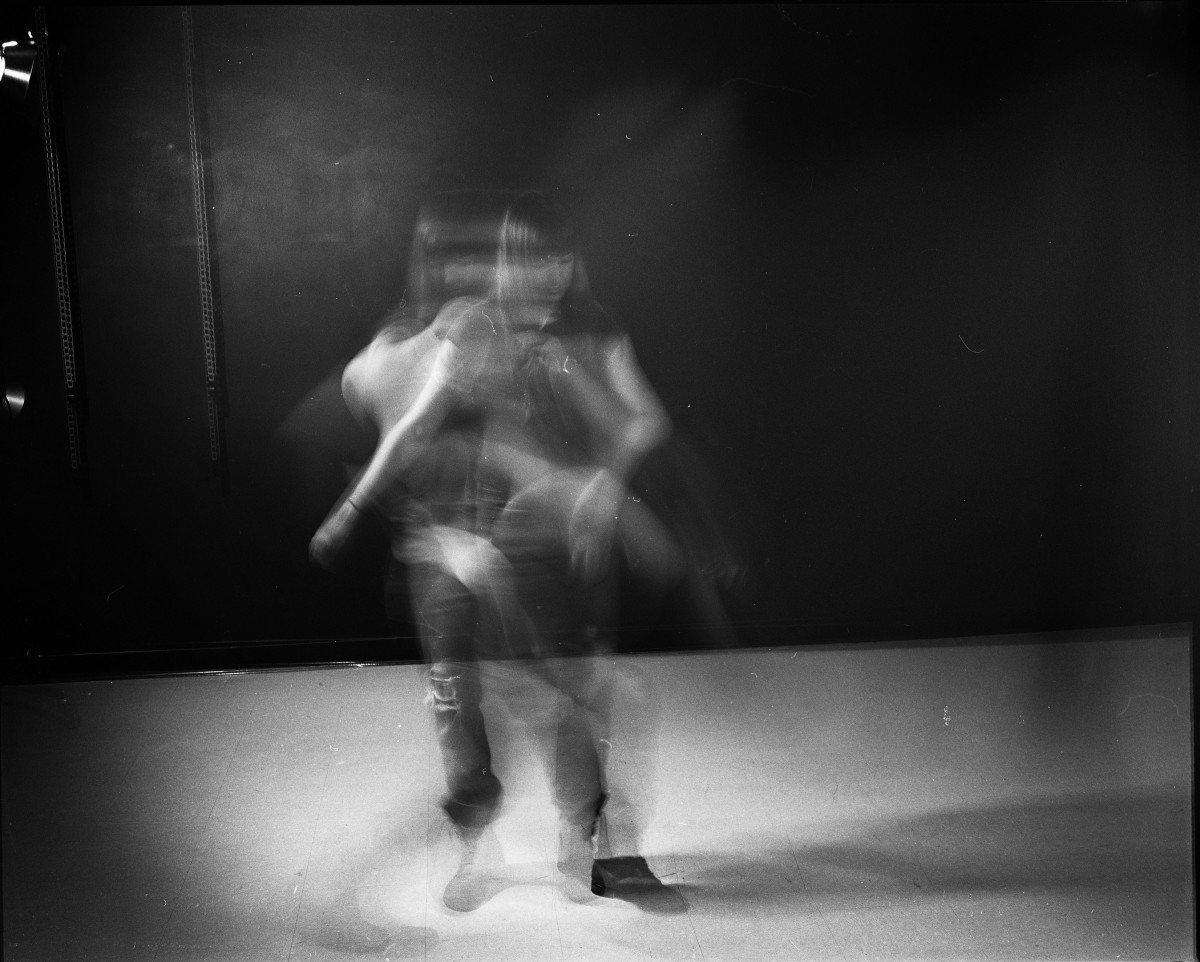

Personal photograph by author. 2014. By Lauren Steury.
Black and white medium format photography. What is it like to move like a cyborg, to be a cyborg? to be a woman? to move in space and light?
Personal photograph by author. 2014. By Lauren Steury.
A joke, of sorts.

Woman Shots. N.d. Josh’s Awesome 3D Blog of Awesomeness. Web. 18 Nov. 2014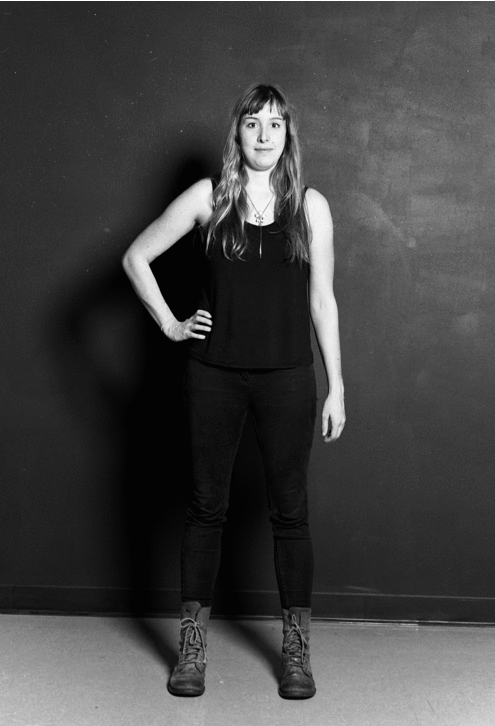
Recreating the 3D woman. Lauren Steury. 2014.
http://vimeo.com/112213157
2nd Iteration of iCyborga by Lauren
Lauren Steury
Making Meaning Matter
November 4, 2014
iCyborga
We make our identities tangible through material object and place- however, with emerging technology, the construction and consumption of identity is transferred to the digital rather than the physical. Virtual identities, assembled through social media, dating sites, personal blogs, and websites- may or may not correspond to real life (RL) identities, though they are axiomatically related:
Digital identity construction (Nguyen and Alexander 1996) makes it possible to express latent and nested identities (Herb and Kaplan 1999) or to more fully disclose aspects of the self that are difficult to represent physically. Alternatively, CMEs (computer mediated environments) also enable people to conceal aspects of their selves that they find undesirable (Schau and Gilly 388).
Aren’t our idyllic selves creations and expression that are just as valid as our ‘real life’ selves? Gender, age, appearance, personality are all social constructs upheld through silent agreement of shared culture. Now, through increased access to semiotic tools and cultural artifact (Appadurai 1996) the self is overtly constructed, duplicated, multiple identities can be expressed, and referencing of brands, symbols, texts, pop culture, is easier than ever through a digital medium and refined for social consumption. Digital tools and easy access to the web are diversifying and complicating the discourse on identity as Hope Jensen Schau and Mary C. Gilly address in We Are What We Post? Self-Presentation in Personal Web Space:
Identities often consist of abstractions left intangible by intention (we are what we choose not to have by voluntary abstention), as a result of few resources (we cannot afford to consume what would flesh out or identities), through denial (we choose not to reveal aspects of identity or obscure their presence), or because the identities are not prone to concrete expression (we cannot locate strategies to express complex facets of our identities)… Personal Web space, with its limitless digital symbols may allow researchers a glimpse of the selves consumers wish they had (Schau and Gilly 387).
The web has made self-representation possible through intangible, non physical objects while still allowing for the same implied meaning of such objects. It is no secret that these new modes of expression are highly edited and sculpted, so the illusion of creation is unveiled. With the heightened awareness that these identities are partial truth, partial fantasy, we tend to take this personal information at face value and more or less accept it as both truth and construct whether it be a comment on life experience, physical appearance, gender, or personality.
These emerging theories on identity creation and how technology complicates said creation are central to cyberfeminist theory which is where my work as an artist emerges from. In working with 3D printing I can’t avoid the meta-symbolism of construction, and reproduction. The (dis)connection between (wo)man and machine and how the boundaries between them become blurred, is at the heart of my 3D printing and film work.
To explore the coupling of woman and machine, one must look to Donna Hanaway’s Cyborg Manifesto where she defines a cyborg as a “cybernetic organism, a hybrid of machine and organism, a creature of social reality as well as a creature of fiction” (Haraway 291). But the cyborg is so much more, as Haraway explains:
My cyborg myth is about transgressed boundaries, potent fusions and dangerous possibilities which progressive people might explore as one part of needed political world… From one perspective, a cyborg world is about the final imposition of a grid of control on the planet…waged in the name of defense, about the final appropriation of women’s bodies in a masculinist orgy of ware. From another perspective a cyborg might be about lived social and bodily realities in which people are not afraid of their joint kinship with animals and machines, not afraid of permanently partial identities and contradictory standpoints (Haraway 295).
The cyborg is the rebellious, illegitimate child of technology and military that strays into the radical abolition of power structures such as gender. It undermines the animal-human, nature-machine, physical-nonphysical (virtural) boundaries that cyberfeminism brings into question. The Culture of Copy explains not only our obsession with creating in our own image (which I am literally doing) but also how we use artificial life as metaphor for ourselves. We shape our definition of life and intelligence in tandem with our experience of hardware and software, for example, the virus, and the obsession with making a machine that can think and feel (Alan Turing). Just as capitalist, patriarchal society seeks hegemony, computer science in many regards seeks to make a machine that can “pass” as human:
There is little difference, come to think of it, between the passing of a man for a woman, a machine for a human, an Indian for an Englishman, or a black man for a white man in the Turing test. An epitome of our culture of the copy, the tests appears to be a fine filter for the uniquely human, but presupposes, as did Turing, that passing is profitable…” (Schwartz 352).
Hegemony shows himself even in machines, therefore feminism will respond through radicalizing the discussion of the cyborg. When the personal is political, how do we maintain our sense of self, agency, and power, when our bodies themselves can be scanned, transformed, manipulated even outside of our own control?
I will make a film that continues this question of a machine passing (and intentionally failing) to show the irony and humor in the (wo)man/machine relationship:
The cyborg is our ontology; it gives us our politics. The cyborg is a condensed image of both imagination and material reality, the two joined centers structuring any possibility of historical transformation (Haraway 297).
The idea of a cyborg, (wo)man/machine, or beast/human, is not new as we know from the classic literature of Mary Shelleys Frankenstein. Shelley Jackson (a precursor to my own cyborg creation through film and 3D printing) reworks the digital, female form of Frankenstein in Patchwork Girl a hypertext. Jenny Sunden cites the piece in her analaysis of the human monster, and the creation of womans body in technology:
Interlinkages between text, body, and machine are always present in acts of writing/reading, but they become explicitly intimate when texts are digitized…The body of the female monster created through digital texts and images becomes entwined with the body of the reader through his or her physical engagement with the computer… (Sunden 152)
I seek to build on this body of digital/human engagement with the idea of cyborgs by reproducing my own image in 3D and positioning ‘her’ as an embodiment of my digital self. I am taking my digital identity, carefully constructed for social approval and consumption and birthing it into the physical world. Just as Hathaway argues that cyborgs cross the physical and virtual boundaries, my 3D self will be a cyborg come to life through film. My 3D doppelganger will replace me as a way of taking my virtual identity or “digital double” into the physical world. This film will stay relevant and interesting through humor and irony. I am responding to Haraway’s Cyborg Manifesto and using it as my inspiration.
Irony is about contradictions that do not resolve into larger wholes, even dialectically, about the tension of holding incompatible things together because both or all are necessary and true. Irony is about humour and serious play. It is also about rhetorical strategy and a political method, one I would like to see more honoured within socialist-feminism (Haraway 292).
I am using the cyborg as a reference to the feminist dialogue with technology and nature. Technology is influenced, even derivative of, society and culture and therefore from normativity and patriarchy. Where eco-feminism seeks to return to nature (the mother) cyberfeminism seeks to use technology as a radical tool for deconstruction and as a platform for change. On the Importance of Being a Cyborg Feminist, Kyle Munkittrick uses the analogy of eco-feminists fighting fire with water, to cyber feminism fighting fire with fire. Cyberfemnism gives us the tools to deconstruct the very definition of “human” which changes alongside time and innovation. My work is a dialogue with what it means to be human, specifically female, in a patriarchal world. The film will, through a feminist lens, act out the ironic relationship between cyborg and woman, technology and humanity, finite and infinite.
The skeleton of my work has been clearly outlined here, through identity construction via technology, cyberfeminism, irony/humor, and feminist politics. The conversation happening between these texts and the present moment is where my film lies. I will birth my virtual identity into physicality through 3D printing. Through film, I can (humorously) depict how a cyborg version of my idyllic self could play my role in life, by replacing me in my everyday routine. My cyborg rises with the sun, she meditates, does yoga, interacts with my lovers, goes to a coffee shop, has ‘girl talk’ with friends, and is positioned, like me, as a white, 20-something, polyamorous, pansexual female in 2014. The cyborg, and therefore my use of the cyborg in film, as a symbol of dualism and unity, bounded and the boundless, past/present/future, is the perfect tool to explore the expression of identity and the future of feminism. My film is taking the self-portrait, the selfie, copy culture and identity in relation to feminism and technology, to the next level.
Works Cited
Smelik, Anneke, and Nina Lykke. “An Introduction.” Bits of Life: Feminism at the
Intersections of Media, Bioscience, and Technology. Seattle: U of Washington, 2008. Print.
Sunden, Jenny. “What If Frankenstein(‘s Monster) Was a Girl?” Bits of Life: Feminism at the Intersections of Media, Bioscience, and Technology. Seattle: U of Washington, 2008. Print.
Jensen Schau, Hope, and Mary C. Gilly. “We Are What We Post? Self‐Presentation In Personal Web Space.” Journal of Consumer Research 30.3 (2008): 385-404. JSTOR. The University of Chicago Press. Web. 4 Nov. 2014. <http://www.jstor.org/stable/10.1086/378616>.
Schwartz, Hillel. “Discernement.” The Culture of the Copy. New York: Zone, 1996. 352. Print.
Haraway, Donna. “A Cyborg Manifesto.” The Cybercultures Reader. London: Routledge, 2000. Print.
Munkittrick, Mark. “On the Importnace of Being a Cyborg Feminist.” Humanity. 21 July 2009. Web. 4 Nov. 2014.
Appadurai, Arjun. Modernity at Large: Cultural Dimensions of Globalization. Minneapolis: U of Minnesota, 1996. Print.



